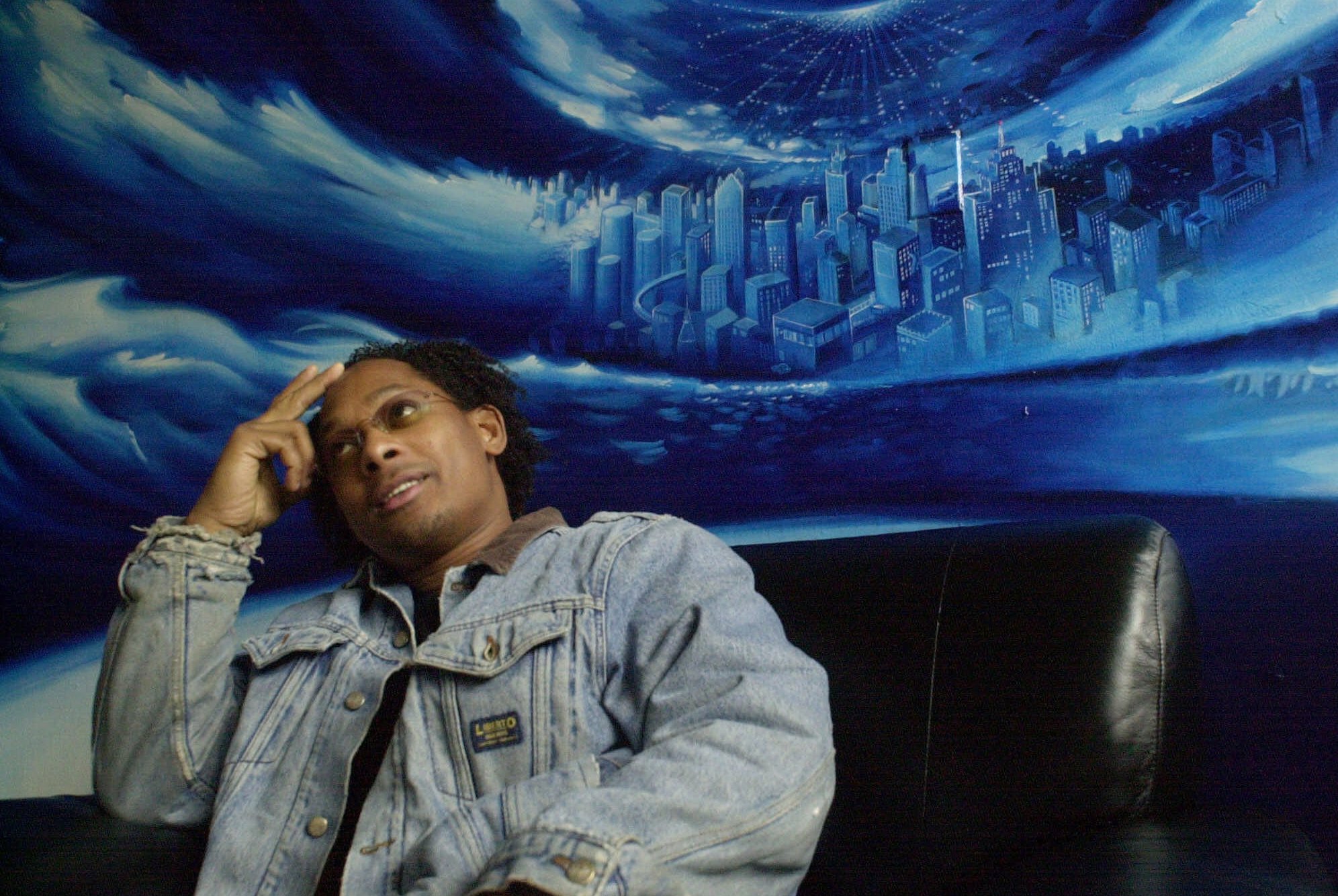The following essay was written for a now-defunct Patreon page, my unsuccessful attempt to freelance without having to write pitches. It is reproduced as part of our Resurrection series, which excavates writing lost to the graveyard of the internet.
I was at Plastic People, a now-defunct basement club in Shoreditch, London, sometime in early 2008. Long plagued by licensing and noise violations, the club was forced to close its doors for good in 2015. But while I was living in London, during a year studying abroad at Goldsmiths College, it was known to have the best sound system in town. Dubstep, the newest indigenous style of UK dance music, had taken over the city that year, with its languid half-time clatter and endlessly descending bass lines. Plastic People hosted one of its first regular parties, FWD. But I was there to see Derrick May, a techno DJ from Detroit.
It was 20 years before the night I saw him that Derrick May had first played in England, when the so-called Second Summer of Love introduced the rave phenomenon to concerned parents everywhere. May had started his career by producing some of the earliest Detroit techno records, under the name Rhythim is Rhythim, before he decided to dedicate his career to spreading the gospel of techno music across the planet as a DJ.
I’d never seen a DJ perform before. Up until that point, I didn’t know a DJ could perform. Sometimes they don’t — someone idly running through the week’s Top 40 usually can’t be accused of much artistry. But electronic music requires a DJ skilled at the craft. Most strictly defined, the DJ’s job is to ensure the music doesn’t stop, allowing listeners to get from Point A to Point B without having to stop dancing. A serious DJ creates a collage, producing what Dadaist visual artist Max Ernst called an “unexpected reconciliation” between disparate elements. On a canvas, these components can be reconciled through their shared flatness, but a DJ’s canvas is intangible: it’s time itself, in the form of rhythm. As Derrick May once put it, in a fascinating documentary for French television called Universal Techno, the DJ’s art is to “make music out of music.” A whole range of practices followed this early innovation, based in New York disco and Chicago house music, from the jarring juxtapositions of mashups to the subtly layered landscapes of minimal techno.
You may experience a temporal glitch in hearing the transition from one record to another. By the time you’re aware of the next track, you’ve already been dancing to it for a few minutes. Hearing this unbroken stream of rhythm can lull you into a hypnotic state. For those unfamiliar with the music, it’s not just a new style; it’s a new medium in sound. It isn’t comprehensible within the standards of a concert performance, just as a painting isn’t evaluated on the same terms as a sculpture. (If you’ve never heard it before, give this Derrick May mix from 1996 a try.)
That night, I didn’t quite understand what was happening, until a moment of recognition marked with fanfare. May had mixed in a track that noticeably interrupted the texture of synthetic sound. It prominently featured the guttural snarl of a saxophone — a human body breathing into the circuitry of the machine. It was suddenly clear to me how to listen to this music. Being new to the experience, it didn’t occur to me to ask May what the track was — and in retrospect, I’m glad I didn’t interrupt him. But the next day, I began a search for that record, that led, inadvertently. to an immersion in electronic music that has lasted nearly a decade.
Underground Resistance — Hi Tech Jazz
Needless to say, my search started in Detroit. Underground Resistance heralded the first major movement in techno music after its first wave, led by May, Juan Atkins, and Kevin Saunderson. UR began as a group consisting of “Mad” Mike Banks, Robert Hood, and Jeff Mills, who produced techno tracks of unprecedented speed and aggression. They eventually went their separate ways, Hood setting the template for what came to be called minimal techno, and Mills reaching for new lengths of sonic extremity. Underground Resistance became both the outlet for Banks’s individual productions, and the name of a militant musicians’ collective under his aegis. This grouping began to incorporate not only more dance producers and DJs, but also Detroit jazz musicians, leading to compositions like “Hi-Tech Jazz.” This particular track isn’t my personal favorite of the group’s jazz excursions (many are collected on a stunning compilation called Galaxy 2 Galaxy), but it distinguishes itself with its prominent horn line.
Kenny Dixon, Jr. — Yesterdays
Dixon is better known by his nom de plume, Moodymann. In the mid-90s, he pioneered a new approach to dance music in Detroit. Instead of emphasizing synthesizers and sequencers, like the Roland 808 and 909 drum machines beloved by his compatriots, he created his tracks primarily with an Akai MPC sampler, the machine being used by hip-hop producers of the day to make beats. Much of his early work is collected on the compilation Silentintroduction, an essential document of the emergence of Detroit’s unique house sound. But a lot of great Moodymann music from the era never made it to LP, including this EP credited to his human alter ego. “Yesterdays” is built on a sample of the groove from Geraldine Hunt’s 1980 disco cut “Can’t Fake the Feeling,” garnished with a saxophone of unknown provenance.
Kenlou — Moonshine
Kenny “Dope” Gonzalez and “Little Louie” Vega usually go by the name Masters at Work. This production shows the same attention to hip-hop as can be heard in Moodymann’s work — unsurprising given their New York roots, and earlier dalliances in instrumental hip-hop. The pair have worked with a range of musicians, from New York house godfather Todd Terry to Latin jazz legend Tito Puente, and often experiment with a range of styles, extensively incorporating live musicians. This house track, though, cleverly loops a few bars of Gil Scott-Heron & Brian Jackson’s “Home is Where the Hatred Is,” from their 1976 record It’s Your World, featuring the sound of Black Panther Party member Bilal Sunni-Ali’s tenor sax.
Laurent Garnier — The Man with the Red Face
A French expatriate in Manchester when house music began its UK takeover, Laurent Garnier caught the wave at the now-legendary Hacienda club. Already a disco DJ, he proceeded to help launch the eventual explosion that blew the minds of Brits like The Stone Roses and The Happy Mondays, and began bringing the likes of Derrick May across the pond. Upon Garnier’s eventual return to Paris, he made a name for himself not only as one of continental Europe’s earliest dance DJs, but one its most serious producers of house and techno music in the American tradition. “The Man with the Red Face” is from his 2000 album Unreasonable Behavior, its neo-blaxploitation movie beat underlying improvisations by French jazz musician Philippe Nadaud.
Son of Raw — A Black Man in Space
Dennis Ferrer is a New York producer whose career has spanned a wide breadth since the mid-1990s, from gritty underground house to minimal techno of the kind that dominated European clubs in the 2000s. A brilliant example of the former, “Son of Raw,” gave him the moniker he used for a song that splits the difference between the styles, “A Black Man in Space.” This one was released in late 2007, so Derrick May is likely to have packed it in his record bag that night at Plastic People. An uncredited saxophone player graces the appropriately named “Sax Mix,” laying mesmerizing riffing reminiscent of 1970s Afrobeat over a slightly ominous electronic texture. The saxless “Original Mix” substitutes voiceover narration, presumably by Ferrer, throwing down a gauntlet in basso profundo: “They call it the final frontier. I call it just the beginning.”
Lil Louis — I Called U (The Conversation)
A final possibility came across my path after I had more or less given up the search. This one, from a Chicago House producer called Lil Louis, includes perhaps the most vivid saxophone improvisation of any classic dance track. It was performed by Chicago stalwart Alfonzo Hunter, who went on to become a backing vocalist for R. Kelly before striking out on his own as a singer. On “The Conversation,” however, he plays sax, weaving his solo through a game of phone tag, heard in snippets of dialogue, over a beat that reminds us time keeps passing, without the titular conversation taking place. The first half is sprinkled with crowd noise, suggesting listeners in a physical space hearing Hunter’s playing. But the second half quiets down, and he begins repeating intricate, insistent motifs, as though in a trance. His riffs demonstrate that it is not just rhythm, but tonality and sonority that can compel motion from listeners. The crowd noise comes back in at the end of the track’s eight or so minutes. It is not, by that time, the applause of culmination, but anticipation. The DJ has already mixed in the next track, and you have no intention to stop dancing.

According to fan-assembled setlists online, Derrick May has played every one of these tracks in a club at some point. The historical record suggests that the one I heard at Plastic People was almost certainly “A Black Man in Space,” though I find that “The Man with the Red Face” gives me a sensation that feels like a flashback. The possibility also remains that it was something I’ll never track down. Maybe it was an unreleased “whitelabel,” something never released to the public, handed to May by a local producer back in Detroit, or during his travels around the world, and the only time he ever played it was that night.
But it doesn’t really matter. The hunt led me back to Plastic People repeatedly during my year in London, to hear Robert Hood, Theo Parrish, and a series of other great DJ’s, from Detroit and elsewhere. And I carried the music home with me — literally, in a suitcase full of vinyl, purchased over the course of many trips to the record shops on Berwick Street. Each one of these records was in it.
Without tending, the digital commons decay or are ruined; Resurrection is Popula’s contribution to the effort to restore valuable works that have disappeared from the public web.
Shuja Haider






